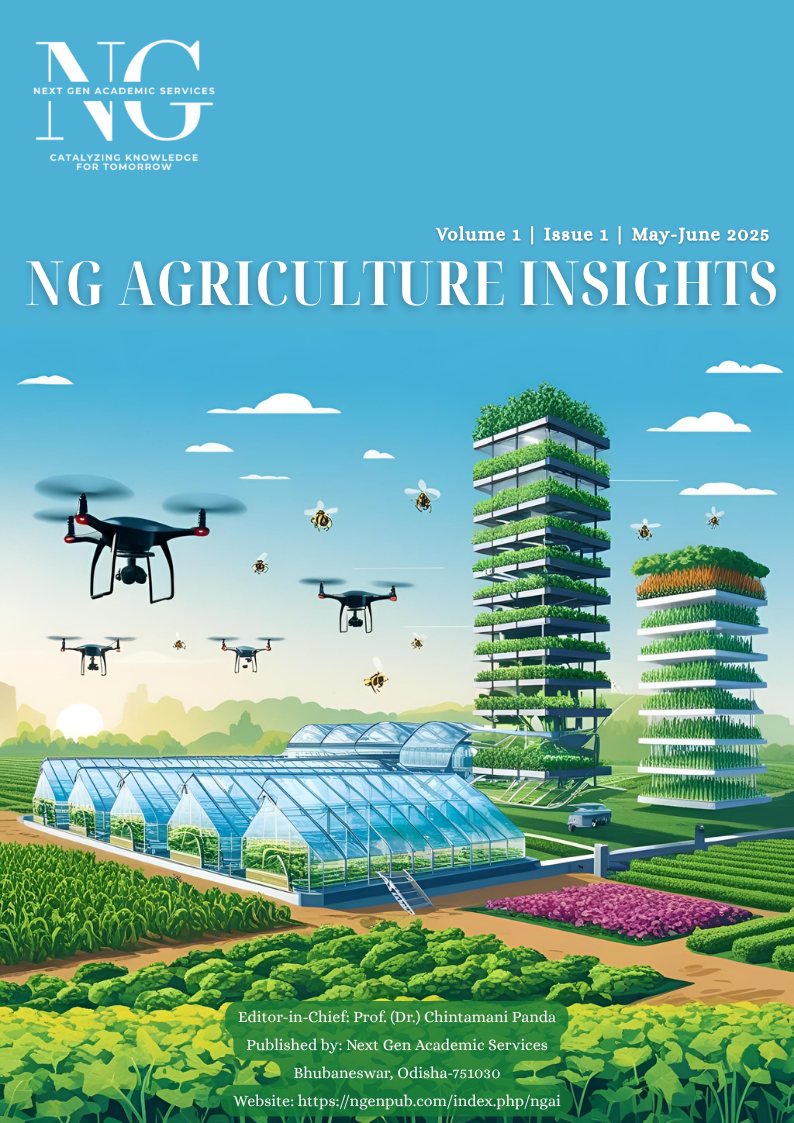The Hidden World Within: Insect Microbiomes and Agricultural Pest Management
DOI:
https://doi.org/10.5281/zenodo.15505358Keywords:
Agricultural entomology, Insect microbiome, Pest management, RNA interference, Sterile insect techniqueAbstract
Nature depends on insects for pollinating food, breaking apart decaying matter and supplying food. But some insects invade crops, which creates numerous problems for farmers and the economy. Though chemical insecticides have been used, they are a concern for both the environment and humans. Managing pests and preserving nature is being researched by exploring the insect microbiomes filled with bacteria, fungi and viruses. As electrophoresis, sequencing the 16S rRNA gene, and metagenomics have advanced, studies of microbiomes have also advanced. What we learn helps improve the ways we manage pests. In IPM, a mix of biological organisms, specially designed crops and cultural approaches, supported by microbiome answers, is used. With RNA interference, pest genes are blocked, which prevents them from reproducing. In SIT, scientists release sterile male insects so they will mate with wild female insects. The use of microbiome strategies is exciting, but there are still problems because insect microbiomes are so complex. In the coming years, scientists need to learn more about how these chemicals affect the environment and our well-being. Researchers, industry experts and policymakers must collaborate to make large-scale implementation happen.
References
Aronna, M. S., & Dumont, Y. (2020). On nonlinear pest/vector control via the sterile insect technique: Impact of residual fertility. Bulletin of Mathematical Biology, 82, 110. https://doi.org/10.1007/s11538-020-00790-3
Belachew, G. T., Hanumanthaiah, P., & Tekelemariam, B. A. (2021). Application of Genome Editing Technologies for Disease Treatment: Review. Journal of Pharmaceutical Research International, 33(19A), 1–17. https://doi.org/10.9734/jpri/2021/v33i19A31320
Devi, W. D., Bonysana, R., Kapesa, K., Mukherjee, P. K., & Rajashekar, Y. (2023). Edible insects: as traditional medicine for human wellness. Future Foods, 7, 100219. https://doi.org/10.1016/j.fufo.2023.100219
Gupta, A., & Nair, S. (2020). Dynamics of insect–microbiome interaction influence host and microbial symbiont. Frontiers in Microbiology, 11, 1357. https://doi.org/10.3389/fmicb.2020.01357
Indriati, G., Susilawati, Puspitasari, M., Soesanthy, F., & Tresniawati, C. (2022). Insect diversity on toxic candlenut (Reutealis trisperma) plantation in Bajawa, East Nusa Tenggara. IOP Conference Series: Earth and Environmental Science, 974(1), 012131. https://doi.org/10.1088/1755-1315/974/1/012131
Jang, S., & Kikuchi, Y. (2020). Impact of the insect gut microbiota on ecology, evolution, and industry. Current Opinion in Insect Science, 41, 33-39. https://doi.org/10.1016/j.cois.2020.06.004
Jeon, J., Rahman, M.-M., Han, C., Shin, J., Sa, K. J., & Kim, J. (2023). Spodoptera frugiperda (Lepidoptera: Noctuidae) Life Table Comparisons and Gut Microbiome Analysis Reared on Corn Varieties. Insects, 14(4), 358. https://doi.org/10.3390/insects14040358
Keswani, C., Prakash, O. M., Bharti, N., Vílchez, J. I., Sansinenea, E., Lally, R. D., ... & Singh, H. B. (2019). Re-addressing the biosafety issues of plant growth promoting rhizobacteria. Science of the Total Environment, 690, 841-852. https://doi.org/10.1016/j.scitotenv.2019.07.046
Lakicevic, B., Nastasijevic, I., & Dimitrijevic, M. (2017). Whole genome sequencing: An efficient approach to ensuring food safety. IOP Conference Series: Earth and Environmental Science, 85(1), 012052. https://doi.org/10.1088/1755-1315/85/1/012052
Limbu, J., Shrestha, B. K., Shakya, J., Khatri, S. B., & Khanal, H. (2020). Isolation of Bacillus thuringiensis and its Insecticidal Effect against Galleria mellonella. Himalayan Journal of Science and Technology, 4, 96–102. https://doi.org/10.3126/hijost.v4i0.33918
Mondal, S., Somani, J., Roy, S., Babu, A., & Pandey, A. K. (2023). Insect microbial symbionts: Ecology, interactions, and biological significance. Microorganisms, 11(11), 2665. https://doi.org/10.3390/microorganisms11112665
Pandit, M. A., Kumar, J., Gulati, S., Bhandari, N., Mehta, P., Katyal, R., Rawat, C. D., Mishra, V., & Kaur, J. (2022). Major Biological Control Strategies for Plant Pathogens. Pathogens, 11(2), 273. https://doi.org/10.3390/pathogens11020273
Pati, P., Behera, S. K., Raghu, S., & Annamalai, M. (2021). Biological control of insect pests in vegetable crops: An eco-friendly approach. International Journal of Current Microbiology and Applied Sciences, 10(1), 1358–1373. https://doi.org/10.20546/ijcmas.2021.1001.162
Singh, A., Bhardwaj, R., & Singh, I. K. (2019). Biocontrol agents: Potential of biopesticides for integrated pest management. In B. Giri, R. Prasad, Q. S. Wu, & A. Varma (Eds.), Biofertilizers for sustainable agriculture and environment (Vol. 55, pp. [chapter pages if known]). Springer. https://doi.org/10.1007/978-3-030-18933-4_19
Singh, S., Singh, A., Baweja, V., Roy, A., Chakraborty, A., & Singh, I. K. (2021). Molecular Rationale of Insect-Microbes Symbiosis—From Insect Behaviour to Mechanism. Microorganisms, 9(12), 2422. https://doi.org/10.3390/microorganisms9122422
Downloads
Published
Issue
Section
License
Copyright (c) 2025 Om Prakash Meena (Author)

This work is licensed under a Creative Commons Attribution 4.0 International License.





